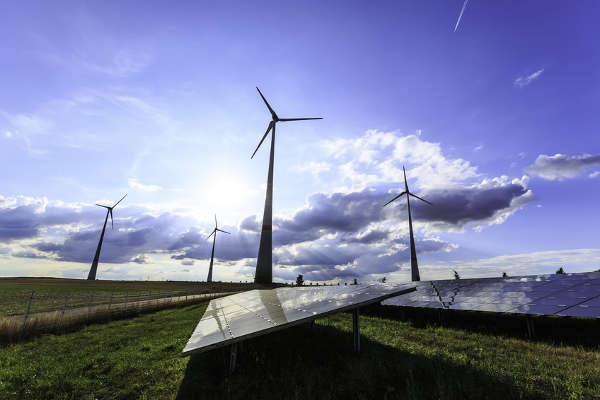This was according to new research published by UN Environment, the Frankfurt School — UNEP Collaborating Centre and Bloomberg New Energy Finance (BNEF).
Global Trends in Renewable Energy Investment 2017 finds that wind, solar, biomass and waste-to-energy, geothermal, small hydro and marine sources added 138.5 gigawatts to global power capacity in 2016, up almost 9 per cent from the 127.5 gigawatts added the year before. The added generating capacity roughly equals that of the world’s 16 largest existing power producing facilities combined.
Investment in renewables capacity was roughly double that in fossil fuel generation; the corresponding new capacity from renewables was equivalent to 55 per cent of all new power, the highest to date. The proportion of electricity coming from renewables excluding large hydro rose from 10.3 per cent to 11.3 per cent. This prevented the emission of an estimated 1.7 gigatonnes of carbon dioxide.
The total investment was $241.6 billion (excluding large hydro), the lowest since 2013. This was in large part a result of falling costs: the average dollar capital expenditure per megawatt for solar photovoltaics and wind dropped by over 10 per cent.

Investment in renewables capacity was roughly double that in fossil fuel generation in 2016 say researchers. (Stock image)
Credit: © ptyszku / Fotolia
“Ever-cheaper clean tech provides a real opportunity for investors to get more for less,” said Erik Solheim, Executive Director of UN Environment. “This is exactly the kind of situation, where the needs of profit and people meet, that will drive the shift to a better world for all.”
New investment in solar totalled $113.7 billion, down 34 per cent from the record high in 2015. Solar capacity additions, however, rose to an all-time high of 75 gigawatts. Wind made up $112.5 billion of investment globally, down 9 per cent; wind capacity additions fell to 54 gigawatts from the previous year’s high of 63 gigawatts.
“The investor hunger for existing wind and solar farms is a strong signal for the world to move to renewables,” said Prof. Dr. Udo Steffens, President of Frankfurt School of Finance & Management, commenting on record acquisition activity in the clean power sector, which rose 17 per cent to $110.3 billion.
While much of the drop in financing was due to reduced technology costs, the report documented a slowdown in China, Japan and some emerging markets, for a variety of reasons.
Renewable energy investment in developing countries fell 30 per cent to $117 billion, while that in developed economies dropped 14 per cent to $125 billion. China saw investment drop 32 per cent to $78.3 billion, breaking an 11-year rising trend.
Mexico, Chile, Uruguay, South Africa and Morocco all saw falls of 60 per cent or more, due to slower than expected growth in electricity demand, and delays to auctions and financings. Jordan was one of the few new markets to buck the trend, investment there rising 148 per cent to $1.2 billion.
The US saw commitments slip 10 per cent to $46.4 billion, as developers took their time to build out projects to benefit from the five-year extension of the tax credit system. Japan slumped 56 per cent to $14.4 billion.
“The question always used to be ‘will renewables ever be grid competitive?’,” said Michael Liebreich, Chairman of the Advisory Board at BNEF. “Well, after the dramatic cost reductions of the past few years, unsubsidised wind and solar can provide the lowest cost new electrical power in an increasing number of countries, even in the developing world — sometimes by a factor of two.”
“It’s a whole new world: even though investment is down, annual installations are still up; instead of having to subsidise renewables, now authorities may have to subsidise natural gas plants to help them provide grid reliability,” Liebreich said.
Recent figures from the International Energy Agency cited the switch to renewables as one of the main reasons for greenhouse gas emissions staying flat in 2016, for the third year running, even though output in the global economy rose by 3.1 per cent.
Investment in renewables did not drop across the board. Europe enjoyed a 3 per cent increase to $59.8 billion, led by the UK ($24 billion) and Germany ($13.2 billion). Offshore wind ($25.9 billion) dominated Europe’s investment, up 53 per cent thanks to mega-arrays such as the 1.2 gigawatt Hornsea project in the North Sea, estimated to cost $5.7 billion. China also invested $4.1 billion in offshore wind, its highest figure to date.
Another positive sign came in winning bids for solar and wind in auctions around the world, at tariffs that would have seemed inconceivably low a few years ago. The records set last year were $29.10 per megawatt hour for solar in Chile and $30 per megawatt hour for onshore wind in Morocco.
Reference(s):
Publication: UN Environment, the Frankfurt School — UNEP Collaborating Centre and Bloomberg New Energy Finance (BNEF) | April 6, 2017 (source)














Comments